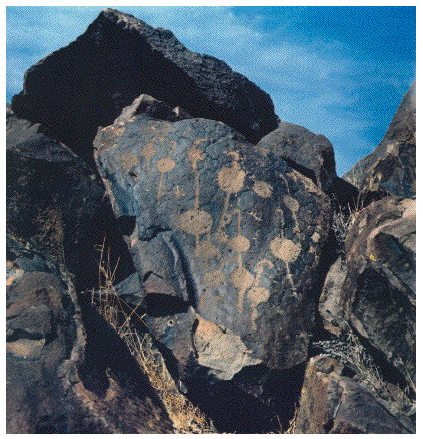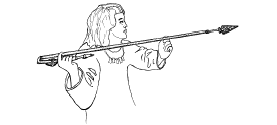PETROGLYPHS
|
|
|
Petroglyphs
on this rock may have been made thousands of years ago. Some people think that these petroglyphs show the "atlatl." This was an ancient tool used before the invention of bows and arrows. Atlatl is an Aztec Indian word for the spear thrower. The atlatl looks like a stick with a hook at the end and a circular stone attached for extra weight. A spear was placed in the hooked end, and thrown. By using the atlatl, hunters could throw their spears further and with greater speed and power. This tool was very useful in hunting the large animals of the Pleistocene era. These petroglyphs are found in Little Petroglyph Canyon near Ridgecrest, Inyo County, California. Tours can be arranged through the Maturango Museum in Ridgecrest.
Edited image from original photograph by Wally McGalliard.
|
PETROGLYPHS
ARCHEOLOGICAL EXHIBITS AND MUSEUMS
|
Calico Early Man Site.
B.L.M. and San Bernardino County Museum. Near Barstow, CA
|
San Bernardino County Museum.
Redlands, CA
|
La Brea Tar Pits and George Page Museum.
Los Angeles, CA
|
Palm Springs Desert Museum.
Palm Springs, CA
|
Mojave River Museum.
Barstow, CA
|
ROCK ART SITES
|
Inscription Canyon, Black Canyon, & Surprise Tank.
contact: B.L.M. Barstow Field Office, Barstow, CA
|
Corn Spring.
contact: B.L.M. Palm Springs Field Office, Palm Springs, CA
|
Little Petroglyph Canyon.
For tours contact: The Maturango Museum, Ridgecrest, CA
|
There may have been people in Southern California more than 15,000 years ago, but the earliest remains with firm dating are about 11,500 years old which would place them at the end of the Pleistocene epoch.
One region where very old archaeological remains are found is the "Great Basin." This is a broad area stretching from southern Idaho to Southern California and includes all, or portions, of Oregon, California, Nevada, Wyoming, Utah, and Colorado. The southwestern parts of this area are now known as the Mojave and Colorado Deserts of Southern California.
At the end of the Pleistocene epoch the climate was quite different. It was cooler and much wetter then, and the area had very large lakes. Remains of fresh water shell fish, water fowl, and mammals have been found. Many remains of the types of animals which roamed the area have been found in the La Brea Tar Pits. There were woolly mammoths, saber tooth cats, sloths, and dire wolves.
Archaeologists call the people of this early time "Paleo-Indians". Remains of these people are extremely rare and sparse. The men, women, and children lived around the large lakes and marshes, and near streams. Much of the information about them is speculative. They were hunter-gatherers. They used stone tools such as spear points, half-round cobble scrapers, gravers, drills, and hammer stones.
Some of the petroglyphs found in the desert areas could have been made by these early people. Several methods of dating the petroglyphs have been developed. One method measures the ratio of certain chemical elements found in the "desert varnish." Desert varnish is an accumulation of chemicals, or "patina", which forms over the surface of the petroglyphs giving them a dark appearance. Ages for some of the petroglyphs have been determined using this method. They range from 19,000 years before the present time to as recently as the mid 19th century.
Many of the early petroglyphs are puzzling and appear very abstract to us. They have either angular or curved geometric shapes, and include crosses, circles, dots, spirals, meanders, or grids. Some symbols are suggestive of human-like or anthropomorphic figures, and others are suggestive of animal or animal-like images.
Sometimes petroglyphs with a lighter colored patina are superimposed over other darker petroglyphs more heavily patinated with desert varnish. It is generally assumed that the lighter superimposed petroglyphs are relatively more recent. A rock art site may have been used for hundreds or thousands of years. Paleo-Indians, Archaic peoples, and ancestors of Native Americans may all have added their marks in the same area. Occasionally petroglyphs show articles from contemporary European and American culture such as horses, and men with large hats. Even trains have been depicted. A steamboat is shown at a site along the Colorado River. These petroglyphs must have been made within the last 200 years.
Images of some hunters are shown with bows, arrows, and dogs. However, some of the human-like forms appear to be hunting big horn sheep with spears. One symbol seems to be an atlatl, or spear thrower. Since the bow and arrow was introduced in this area about 1,500 years ago, petroglyphs showing atlatls are probably older than this date.
|
|
|
|
ATLATL
|
THE ATLATL WAS USED TO THROW SPEARS
|
Rock art has been made over a vast time period in the desert area of Southern California. Some of the rock art was undoubtedly created by the ancestors of people who now live in the area, such as the present day Chemehuevi, Serrano, Cahuilla, Mojave, and Yuma peoples.
Rock art is generally found in remote areas. As more people seek recreation in these areas, they are finding rock art sites. Some people are thoughtful and consider the possible age and meaning of these ancient marks. Others are not as thoughtful. It is only by educating the public that these historical reminders of earlier humans will survive.
Source:
California Archaeology
, Michael J. Moratto, Academic Press, Orlando, Florida, 1984.
Go to contents page | Go to previous section | Go to next section


